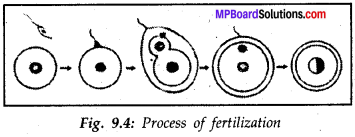In this article, we will share MP Board Class 8th Science Solutions Chapter 9 Reproduction in Animals Pdf, These solutions are solved subject experts from the latest edition books.
MP Board Class 8th Science Solutions Chapter 9 Reproduction in Animals
MP Board Class 8th Science Reproduction in Animals NCERT Textbook Exercises
Mp Board Class 8 Science Chapter 9 Question 1.
Explain the importance of reproduction in organisms.
Answer:
The production of new individuals from their parents cells is known as reproduction. Reproduction is very important as it ensures the continuation of similar kinds of individuals, generation after generation. If reproduction process does not exist, the generation of living beings will be vanished from the earth.
Mp Board Class 8 Science Solution Chapter 9 Question 2.
Describe the process of fertilization in human beings.
Answer:
In human beings, sexual reproduction occurs which is reproduction results from the fusion of male and female gametes. The male reproductive organs are a pair of testis, sperm ducts and penis. The testis produces the male gametes called sperms. Millions of sperms are produced by the testis. Though the sperms are very small in size, each has a head, a middle piece and a tail. Each sperm is a single cell with all the usual cell components.
The female reproductive organs are a pair of ovaries, oviducts and the uterus. Ovary produces female gametes called ova (eggs). In human beings, a single matured egg is released into the oviduct by one of the ovaries every month. Uterus is the part where development of the; baby takes place. Like sperm, an egg is also a single cell.
The first step in the process of reproduction is the fusion of a sperm and an ovum. Millions of sperms from the male are transferred into the female body. The sperms swim in the oviduct with the help of their tails to reach the egg. When they come in contact with the egg, one of the sperms may fuse with the egg.
Such fusion of the egg and the sperm is called fertilization. During fertilization, the nucleus of the sperm and the egg fuse to form a single nucleus. This results in the formation of a fertilized egg or zygote. The new individual inherits some characteristics from the mother and some characteristics from the father.
Class 8 Science Chapter 9 Mp Board Question 3.
Choose the most appropriate answer:
(a) Internal fertilization occurs:
(i) in female body.
(ii) outside female body.
(iii) in male body.
(iv) outside male body.
Answer:
(i) in female body.
(b) A tadpole develops into an adult frog by the process of:
(i) fertization
(ii) metamorphosis
(iii) embedding
(iv) budding.
Answer:
(ii) metamorphosis
(c) The number of nuclei present in a zygote is:
(i) none
(ii) one
(iii) two
(iv) four.
Answer:
(iii) two
Mp Board Solution Class 8 Science Chapter 9 Question 4.
Indicate whether the following statements are True (T) or False (F):
- Oviparous animals give birth to young ones.
- Each sperm is a single cell.
- External fertilization takes place in frog.
- A new human individual develops from a cell called gamete.
- Egg laid after fertilization is made up of a single cell.
- Amoeba reproduces by budding.
- Fertilization is necessary even in asexual reproduction.
- Binary fission is a method of asexual reproduction.
- A zygote is formed as a result of fertilization.
- An embryo is made up of a single cell.
Answer:
- False
- True
- True
- False
- True
- False
- False
- True
- False
- False
Mp Board Class 8 Chapter 9 Question 5.
Give three differences between a zygote and a foetus.
Answer:
The three differences between a zygote and a foetus are:
- Zygote is made up of a single cell while foetus is made up of many Cells.
- Zygote does not have well developed limbs, foetus has well developed and identifiable limbs.
- Zygote is formed by the fertilization of sperms and ovum, foetus is formed by the repeated divisions of the zygote.
Mp Board Class 8 Social Science Solution Chapter 9 Question 6.
Define asexual reproduction. Describe the two methods of asexual reproduction in animals.
Answer:
Asexual reproduction is defined as the type of reproduction in which only a single parent is involved. Budding and binary fission are the two main methods of asexual reproduction.
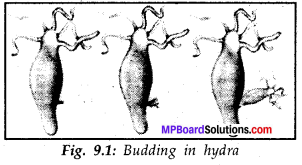
(i) Budding is the method of asexual reproduction that takes place in hydra. Each hydra has two or three bulges which are called buds. These buds develop into new individuals. Since new individuals in hydra are formed from buds, this type of asexual reproduction is known as budding.
(ii) Binary fission: Amoeba is a single celled animal. It begins reproduction by the division of its nucleus into two nuclei. Thus, two amoeba are formed from one amoeba. Since an animal reproduces by division into two individuals, this type of asexual reproduction is called binary fission.
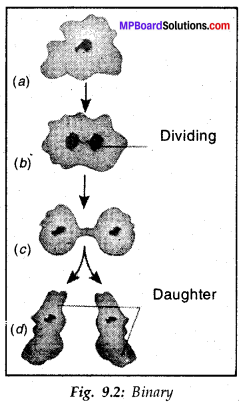
Class 8 Science Chapter 9 Question Answer Question 7.
In which female reproductive organ does the embryo get embedded?
Answer:
The embedding of the embryo takes place in the wall of the uterus of the female for further development.
Mp Board Class 8 Social Science Chapter 9 Question 8.
What is metamorphosis? Give examples.
Answer:
Metamorphosis. It is the drastic change which takes place during the development of an animal into an adult. Frogs and silkworms exhibit metamorphism.
Egg of frog → Tadpole larva → Adult
Tadpoles look different from the adult. But they soon transform into an adult capable of jumping and swimming. Similarly, caterpillar or the pupa of silkworm looks quite different from adult. Also beautiful moth emerges out of the cocoon.
Class 8 Social Science Chapter 9 Mp Board Question 9.
Differentiate between internal fertilization and external fertilization.
Answer:
(i) Internal fertilization – The fertilization which takes place inside the body of the female is called internal fertilization. It occurs in humans and other animals such as cows, dogs and hens.
(ii) External fertilization – The fertilization which takes place outside the body of the female is called external fertilization. It is common in aquatic animals such as frogs, fish and starfish.
Class 8 Science Chapter 9 Question 10.
Complete the cross-word puzzle using’ the hints given below:
Across
1. The process of the fusion of the gametes.
6. The type of fertilization in hen.
7. The term used for bulges observed on the sides of the body of Hydra.
8. Eggs are produced here.
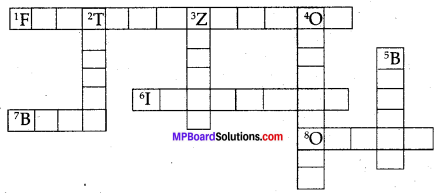
Down
2. Sperms are produced in these male reproductive organs.
3. Another term for the fertilized egg.
4. These animals lay eggs.
5. A type of fission in amoeba.
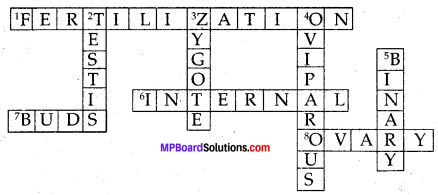
MP Board Class 8th Science Reproduction in Animals NCERT Extended Learning – Activities and Projects
Class 8 Chapter 9 Science Question 1.
Visit a poultry farm. Talk to the manager of the farm and try to find out the answers to the following:
(a) What are layers and broilers in a poultry farm?
(b) Do hens lay unfertilized eggs?
(c) How can you obtain fertilized and unfertilized eggs?
(d) Are the eggs that we get in the stores fertilized or unfertilized?
(e) Can you consume fertilized eggs?
(f) Is there any difference in the nutritional value of the fertilized and undertilized eggs?
Answer:
Do yourself.
Reproduction In Animals Class 8 Questions And Answers Question 2.
Observe live hydra yourself and learn how they reproduce by doing the following activity:
During the summer months collect water weeds from ponds or ditches along with the pond water and put them in a glass jar. After a day or so you may see several hydra clinging to the sides of the jar. Hydra is transparent, jelly-like and with tentacles. It clings to the jar with the base of its body. If the jar is shaken, the hydra will contract instantly into a small blob, at the same time drawing its tentacles in. Now take out few hydras from the jar and put them on a watch glass. Using a hand lens or a binocular or dissection microscope, observe the changes that are taking place in their body. Note down your observations.
Answer:
Do yourself.
Class 8 Science Chapter 9 Solution Question 3.
The eggs we get from the market are generally the unfertilized ones. In case you wish to observe a developing chick embryo, get a fertilized egg from the poultry or hatchery which has been incubated for 36 hours or more. You may then be able to see a white disc-like structure on the yolk. This is the developing embryo. Sometimes if the heart and blood vessels have developed you may even see a red spot.
Answer:
Do yourself.
Chapter 9 Reproduction In Animals Question 4.
Talk to a doctor. Find out how twinning occurs. Look for any twins in your neighbourhood, or among your friends. Find out if the twins are identical or non-identical. Also find out why identical twins are always of the same sex? If you know of any story about twins, write it in your own words.
Answer:
Do yourself.
MP Board Class 8th Science Reproduction in Animals NCERT Intext Activities and Projects
Ch 9 Science Class 8 Activity 9.1
Visit some ponds or soil-flowing streams during spring or rainy season. Look out for clusters of frog’s eggs floating in water. Write down the colour and size of the eggs.
Answer:
The colour of the eggs is dull white and size is less than a centimetre to a few centimetres.
Reproduction In Animals Questions And Answers Activity 9.2
Try to collect eggs of the following organism-frog, lizard, butterfly or moth, hen and crow or any other bird. Were you able to collect eggs of all of them? Make drawings of the eggs that you have collected.
Answer:
Yes, I collected all of these eggs.
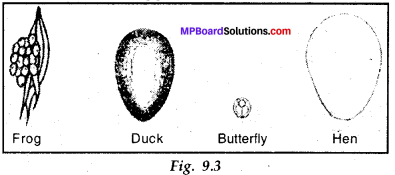
MP Board Class 8th Science Reproduction in Animals NCERT Additional Important Questions
A. Short Answer Type Questions
Class 8th Mp Board Solution Question 1.
Name two organisms which reproduce by splitting their bodies into two parts.
Answer:
Two organisms which reproduce by splitting their bodies into two parts are amoeba and Paramecium.
Class 8 Chapter 9 Solution Science Question 2.
What is reproduction? What’s the need for this process?
Answer:
- The process of producing individuals of their own kind is called reproduction.
- It is an essential for the continuation of similar units of individuals, generation after generations.
Chapter 9 Reproduction In Animal Question 3.
What is fertilization?
Answer:
The process of fusion of male and female gamete in sexual reproduction is called fertilization.
Question 4.
Name the male and female sex organ of animals.
Answer:
The male sex organ is called testes and female sex organ is called ovary.
Question 5.
Give the life cycle of a frog.
Answer:
Egg → early tadpole → late tadpole → adult frog.
B. Long Answer Type Questions
Question 6.
What are the names of male reproductory organs in human beings?
Answer:
In human beings male reproductory organs are a pair of testes, sperm ducts and a penis. Testes are responsible for producing male gametes called sperms. They are transported to the sperm ducts and through the penis, they are ejaculated in female body.
Question 7.
Explain the reproductory organs of female in human beings.
Answer:
In human beings the female reproductory organs are a pair of ovaries, oviducts or fallopian tubes and the uterus. Ovaries are responsible to produce female gamete called ova, which fertilize with male sperm in female fallopian tube and travels to uterus for its development into embryo and the foetus.
Exercise for Practice
Question 8.
Explain the process of fertilization.
Answer:
Sperm is a tiny cell and is quite active for its movement, a thread like structure, the flagellum is found which is called as the tail. Ovum, the female gamete is a large, spherical cell which remains static. When the male and female gamete fuse; a new cell called zygote is formed. This process of fusion is known as fertilization. This zygote undergoes many changes and forms a new individual.
